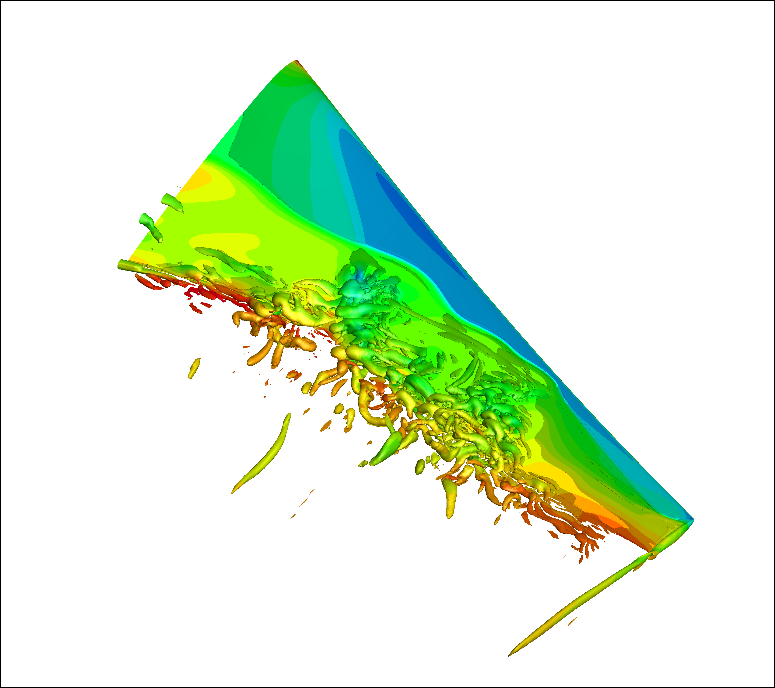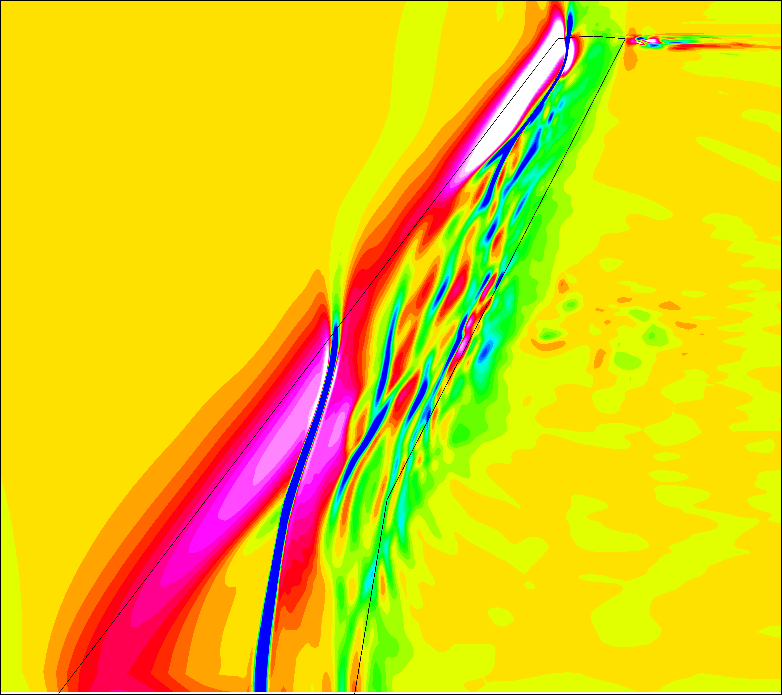Study of numerical simulation for 3-dimensional buffet
JAXA Supercomputer System Annual Report April 2016-March 2017
Report Number: R16E0111
- Responsible Representative: Yuichi Matsuo(Aeronautical Technology Directorate, Numerical Simulation Research Unit)
- Contact Information: Yoimi Kojima(y-kojima@st.go.tuat.ac.jp)
- Members: Yoimi Kojima
- Subject Category: Aviation(Aircraft)
Abstract
Transonic buffet is self-induced oscillation of shock waves appeared on a suction side of a wing. In this project, we simulated the transonic buffet over a NASA-CRM which is similar the actual aircraft shape. The numerical results indicate that spectrum of shock oscillation over the 3D wing exhibits broadband and three-dimensionally oscillation. It is a remarkable feature compared with buffet over the 2D wing which have a narrow band oscillation uniform in the span wise direction.
Goal
To improve the flight performance of the aircraft in transonic range, we simulate the shock wave vibration phenomenon (transonic buffet) , which affects the safety of the aircraft. We simulate buffet over the NASA Common Research Model(CRM) and clarify the mechanism of 3D buffet.
Objective
We establish simulation technology of transonic buffet which is a complicated unsteady phenomenon. Also, in order to utilize it for future aircraft development, we investigate the behavior of transonic buffet over the NASA-CRM and clarify the propagation process of pressure wave.
References and Links
N/A
Use of the Supercomputer
Perform numerical analysis and analyze unsteady data.
Necessity of the Supercomputer
It is indispensable to use supercomputer since numerous computational resources are required for simulation of unsteady, high Reynolds number and high Mach number flow. Also, since the data size of the analysis result is extremely huge, a large amount of memory is required for its analysis.
Achievements of the Year
Transonic buffet is sustained by feedback loop of pressure disturbance as describe below. First, the pressure disturbance caused by the shock wave propagates downstream. Then, a pressure wave generated at the trailing edge of the wing (Kutta wave) propagates upstream. Fig.1 shows the turbulent vortex structure in transonic buffet. As shown in Fig.1, the vortex structure differs greatly depending on the location in the span wise direction. Fig.2 shows the Kutta wave generated at the trailing edge of the wing. It indicates the structure of the Kutta wave differs depending on the location in the span wise direction. These facts indicate that the aspect of the feedback mechanism differs depending on the location in the span wise direction. As a result, complicated buffet is occurred.
Publications
N/A
Computational Information
- Parallelization Methods: Process Parallelization
- Process Parallelization Methods: MPI
- Thread Parallelization Methods: n/a
- Number of Processes: 768
- Number of Threads per Process: 1
- Number of Nodes Used: 24
- Elapsed Time per Case (Hours): 96
- Number of Cases: 5
Resources Used
Total Amount of Virtual Cost(Yen): 3,617,447
Breakdown List by Resources
| System Name | Amount of Core Time(core x hours) | Virtual Cost(Yen) |
|---|---|---|
| SORA-MA | 2,011,056.13 | 3,217,465 |
| SORA-PP | 13,489.58 | 115,174 |
| SORA-LM | 13.10 | 294 |
| SORA-TPP | 0.00 | 0 |
| File System Name | Storage assigned(GiB) | Virtual Cost(Yen) |
|---|---|---|
| /home | 95.37 | 899 |
| /data | 9,765.63 | 92,119 |
| /ltmp | 1,953.13 | 18,423 |
| Archiving System Name | Storage used(TiB) | Virtual Cost(Yen) |
|---|---|---|
| J-SPACE | 56.06 | 173,070 |
Note: Virtual Cost=amount of cost, using the unit price list of JAXA Facility Utilization program(2016)
JAXA Supercomputer System Annual Report April 2016-March 2017




